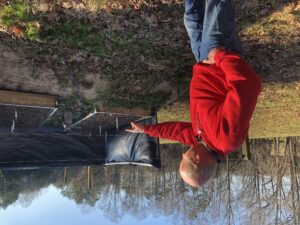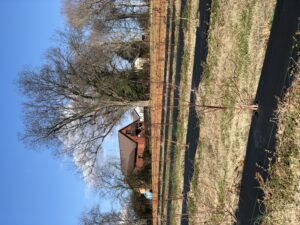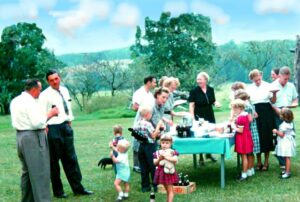Sprinkle’s Blueberry Farm
go.ncsu.edu/readext?846280
en Español / em Português
El inglés es el idioma de control de esta página. En la medida en que haya algún conflicto entre la traducción al inglés y la traducción, el inglés prevalece.
Al hacer clic en el enlace de traducción se activa un servicio de traducción gratuito para convertir la página al español. Al igual que con cualquier traducción por Internet, la conversión no es sensible al contexto y puede que no traduzca el texto en su significado original. NC State Extension no garantiza la exactitud del texto traducido. Por favor, tenga en cuenta que algunas aplicaciones y/o servicios pueden no funcionar como se espera cuando se traducen.
Português
Inglês é o idioma de controle desta página. Na medida que haja algum conflito entre o texto original em Inglês e a tradução, o Inglês prevalece.
Ao clicar no link de tradução, um serviço gratuito de tradução será ativado para converter a página para o Português. Como em qualquer tradução pela internet, a conversão não é sensivel ao contexto e pode não ocorrer a tradução para o significado orginal. O serviço de Extensão da Carolina do Norte (NC State Extension) não garante a exatidão do texto traduzido. Por favor, observe que algumas funções ou serviços podem não funcionar como esperado após a tradução.
English
English is the controlling language of this page. To the extent there is any conflict between the English text and the translation, English controls.
Clicking on the translation link activates a free translation service to convert the page to Spanish. As with any Internet translation, the conversion is not context-sensitive and may not translate the text to its original meaning. NC State Extension does not guarantee the accuracy of the translated text. Please note that some applications and/or services may not function as expected when translated.
Collapse ▲In Winston-Salem, North Carolina, off of Olivet Church Road, hangs a shingle that reads Sprinkle’s Blueberry Farm. There’s a gravel road sandwiched between blueberry bushes on the right and the pastures of Myers horse farm on the left. Flanked on the backside by the Olivet Moravian Church, the appearance is open and rural. Yet we are close to the city. The morning the air is crisp and the bushes are bare. It’s winter. Our host, Lee Sprinkle invites us to enjoy the warmth of a story about his family farm.
What’s your family farm story?
Family records indicate that our farm started in 1836, perhaps earlier. Our story begins with adoption. My great great great grandfather was killed in the Civil War. His son was adopted by the Mickey family and became the sole heir. The Mickey’s handwriting reads, “In return for taking care of Mary, his wife, I’m going to give the land and he will take care of it.”
My grandparents and my uncle Ralph, the Yarboughs, farmed this land with wheat and tobacco. Since that time the original 100 acres have been divided until our current spread of 30 acres.
Growing up, I watched my dad come home from work and tend to four different gardens. We moved onto this family land and he enjoyed spending his retirement farming. He was active in farming into his nineties.
About 1980 he planted 5 acres of pick your own blueberries. He installed drip irrigation systems and planted four varieties for a total of 3600. The field came into production in about 3 years. He had a run of about 20 years of fruit production. Multiple generations of families have come here year after year for the outing and the crop.
We lost dad about 8 years ago.
Have you always been a farmer?
I am a new old farmer.
I graduated from NC State and then went to Forsyth Tech and took classes in heating and cooling. Bob Green came along and shared his vision for creating a high school program for heating and cooling. I helped set up the program and stayed on there as an instructor for about 7 years. Construction has been my field of work since. Like my father, farming is my retirement of choice.
What keeps you getting out of bed and working in these fields?
I can roll out of bed in the morning with some aches and pains and feel seventy years old. On my way to the field the years drop. By the time I get into the field, I am twenty-five years old again. It’s mentally and physically rejuvenating. My brother-in-law Wayne helps me with the tractor work. We’re two old farmers having fun. Getting on the tractor and lining up the rows gives you a good feeling. Using a ledger string with knots we planned the bush planting. Order out of chaos. Maybe the process is the objective.
Sustainability. How has your farm changed recently?
Bill Cline and Celine Richard and others have also helped me to develop a plan. We’re in our third year of replanting. The AgVentures program was a big help. With their encouragement we have increased this year’s goal from planting from 400 to a 1000 bushes. Over 10 varieties are on their way from Oregon, North Carolina and Florida.
We’ve made several improvements. We’ve expanded the rows. We’re using pine chips to increase soil drainage. Pine bark was localized around the roots. I’m concerned about acid levels and iron uptake. The bushes are planted on 12″-14” mounds. In between the rows we have allowed grass to grow which we keep mowed. The blueberry roots are close to the surface and are in competition with the weeds for nutrients. Ground cloth covering protects the irrigation lines from weed growth and from rodents that like to chew. The AgVentures grants also allowed us to install a new drip irrigation system. Before we were hand spreading granular fertilizer, so this saves us a lot of walking.
Propagation. Do you want to see the process? Of course.
Walking up a gentle sloping hill, Lee warns us to look out for gopher holes. The sun is still low on the horizon and the shadows are long, oblique, creating a magical atmosphere.
Every year when I started playing with the idea of rebuilding the blueberry field I kept in mind the time limits on the patents. This process of propagation starts in July or August. I take softwood cuttings off of the tips that are growing and seem to be producing the best. Each of the beds you see there has got about 800 stems in it. My success rate has been dropping off lately, about 50 percent currently. The first stages of propagation must be protected from the wind (We observe a wind break on 3 sides of the propagation beds.) Misters come on every 5 minutes for 5 seconds. The goal is keeping the top moist without the bottom getting wet. Bill Cline told me 18 inches of sand [beneath the propagation bed for drainage] and that was when it started working.
Adjacent to the propagation beds is a garden of young blueberry bushes surrounded by electric wire. Once Lee verifies that the current is off, we duck under and take a look.
Once the propagated stems stay in their bed for about 2 months they hopefully get some roots started. I have to transplant them to allow for space. I reset them in the garden on 6″ spacing. These bushes will be one year old in August. They started as 4″ stems. These will be ready to plant this February.
Tenderly, Lee pulls one bush up to show us the root system. It’s good.
Pine Bark. Magic.
It’s good to find out how easy it is to make a mistake and how easy it is to fix it if you just know what it is. So that’s propagation.
Let’s go to the field.
Bluebirds dot the fields and flit from branch to branch. Lee’s dad built 8-10 bluebird boxes and they’re still standing.
N.C. Cooperative Extension has an upcoming workshop on pruning blueberries. What has been your learning experience with pruning?
That it is a big job that I’m really only learning to do now. Even in backyard blueberries, people think that they can plant a bush without maintenance but it’s just not that way. From what I’ve learned you don’t want a bush that’s more than four years old. Any stems that are over that age need to be removed to allow for the new growth. Every year of stem growth will return a diminishing size of berry. Bill Cline’ has produced some instructive videos on the subject, but I want to know about Celine’s field training program in early February.
If a Forsyth County neighbor planted a blueberry bush, what would be your advice?
Most of the videos from N.C. Cooperative Extension addresses those situations. They have got to put in more than one variety. Pollinators and soil preparation are two main ingredients. You can’t just dig a hole and drop the bush in the ground. You’ve got to add organic matter. Blueberries like water but they don’t want to stand in water. I have been told that if you’ve had a lot of success with azaleas you’ll have success with blueberries.
If you had never eaten a blueberry before, how would you describe the texture, the taste and the sight?
It’s milder and sweeter than a blackberry. Blueberry seeds are smaller. Its color doesn’t always tell you it’s ripe. It needs to be blue for several days for maximum sweetness. Round and hard is not ripe. It tends to turn into more of a pumpkin shape. Blueberries will not ripen if you pull them too early.
Lee holds his hands together in an shape imitative of a pumpkin’s profile.
The American Farm Bureau’s website opens with this quote: An agriculturally literate person understands how the agricultural industry works – not just where food comes from, but who grows it, agriculture’s effect on the economy, environment, technology, lifestyle and its relationship to livestock.
How does agricultural literacy shape our community and create a space for hope in the hearts of individuals?
People are starting to wonder why there are things missing from the shelves of their grocery store. Coming to a farm or to this farm helps convey the idea that food doesn’t come from a factory. There is value in memory. People once used the land to live.
Do you ever think about your legacy?
I have mixed emotions.
I would really like for someone to see that this blueberry farm is viable and to keep it going after I cannot. I am not naïve. Land is becoming too valuable. Thankfully, farms are currently getting favorable tax treatment. People that come to pick blueberries comment that they feel like they are stepping back into their youth. Maybe it’s not real. I don’t know that we’re growing blueberries as much as we’re growing memories.
There’s a large stately pecan tree on the far side of the blueberry field. Its beauty is distracting.
My grandmother lived here and our family would come to visit for family reunions. We had not had a family reunion since 1954. We just had one this past year, 2021. Many members attended and we gathered under a pecan tree, about 90 years old. The last survivor of a group of eight planted by my grandfather. I can recall as a kid in fall using galvanized wash tubs and filling them up. Oddly enough the tree had not produced in recent years. Yet this year after we ate a picnic under its branches, I have picked up 5 gallons of pecans.














